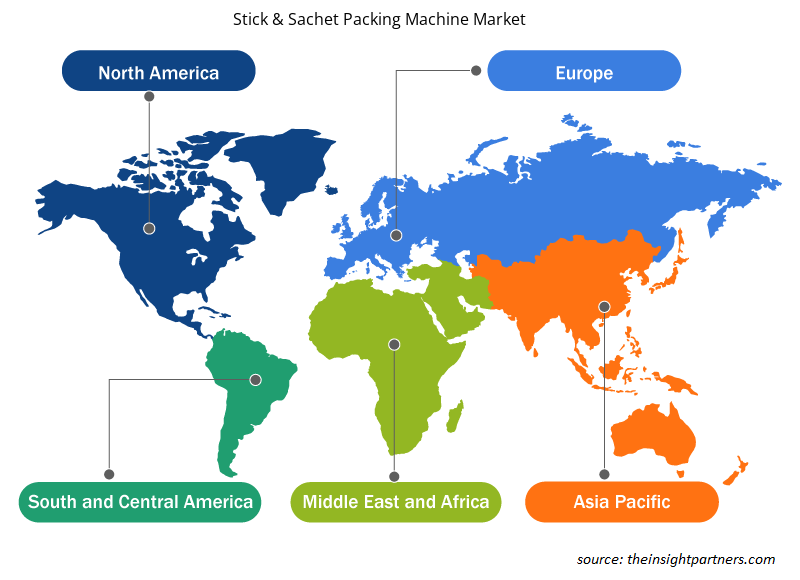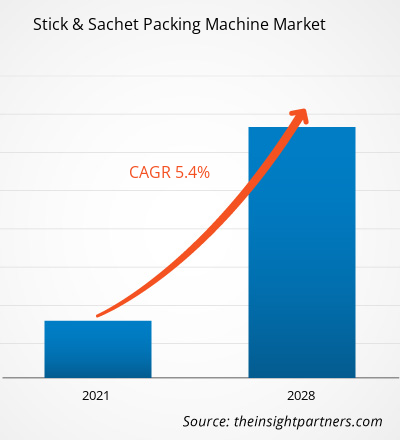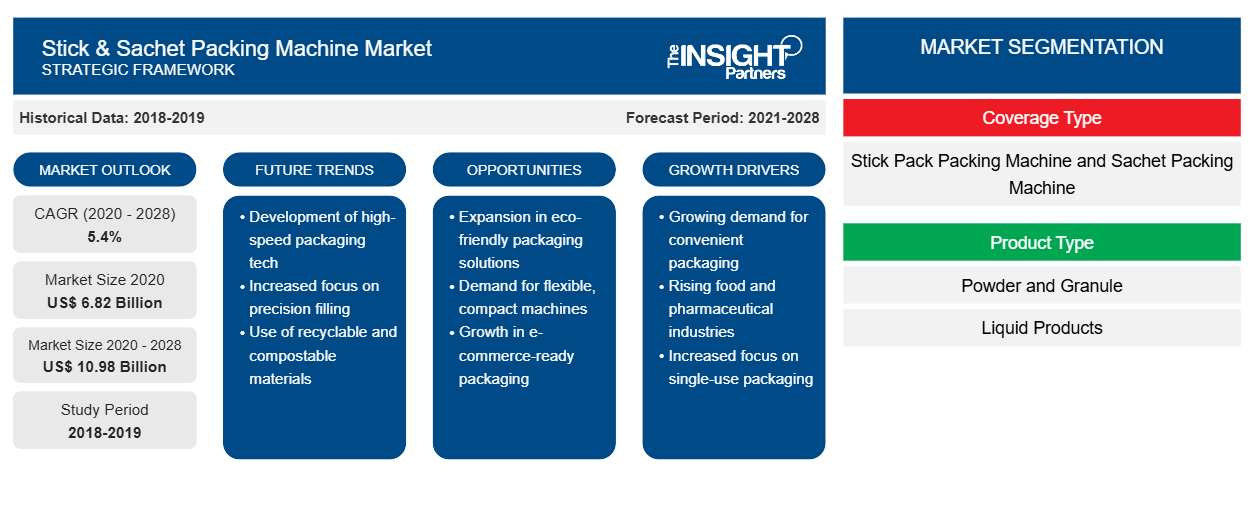Der Markt für Stick- und Sachet-Verpackungsmaschinen wurde im Jahr 2020 auf 6.819,38 Millionen US-Dollar geschätzt und soll bis 2028 10.978,92 Millionen US-Dollar erreichen. Für den Prognosezeitraum wird eine durchschnittliche jährliche Wachstumsrate (CAGR) von 5,4 % erwartet.CAGR of 5.4% during the forecast period.
Die rasante globale Industrialisierung, die steigenden Verbraucherpräferenzen für verpackte Produkte, das Wachstum der Lebensmittel- und Getränkeindustrie, ein zunehmender Fokus auf die Bereitstellung intelligenter Wartungsdienste und eine hohe Optimierung der Verpackungsverfahren sind einige Faktoren, die das Wachstum dieses Marktes im Prognosezeitraum wahrscheinlich ankurbeln werden. In der oben genannten Prognose bieten die Entwicklung der E-Commerce-Branche und die Verbreitung verbesserter Vertriebskanäle zahlreiche Möglichkeiten für das Wachstum des globalen Marktes für Stick- und Sachet-Verpackungsmaschinen.
Wichtige Akteure im globalen Ökosystem des Marktes für Stick- und Sachet-Verpackungsmaschinen sind Rohstofflieferanten, Hersteller von Stick- und Sachet-Verpackungsmaschinen und Endverbraucher. Rohstofflieferanten sind die ersten Akteure auf dem Markt, da sie verschiedene Metalle wie Stahl, Weichstahl, Kunststoffe, glasfaserverstärkten Kunststoff (GFK) und Eisenmetalle liefern. Diese Materialien verbessern die Qualität der Komponenten und sorgen so für eine bessere Leistung und Lebensdauer.
Passen Sie diesen Bericht Ihren Anforderungen an
Sie erhalten kostenlos individuelle Anpassungen an jedem Bericht, einschließlich Teilen dieses Berichts oder einer Analyse auf Länderebene, eines Excel-Datenpakets sowie tolle Angebote und Rabatte für Start-ups und Universitäten.
- Holen Sie sich die wichtigsten Markttrends aus diesem Bericht.Dieses KOSTENLOSE Beispiel umfasst eine Datenanalyse von Markttrends bis hin zu Schätzungen und Prognosen.
Auswirkungen der COVID-19-Pandemie auf den Markt für Stick- und Sachet-Verpackungsmaschinen
Die COVID-19-Epidemie hat sich weltweit negativ auf Fertigungsunternehmen ausgewirkt, der globale Markt für Stick- und Sachet-Verpackungsmaschinen blieb jedoch relativ unberührt. Die Mehrheit der Verpackungsunternehmen ist mit erhöhter Kapazität voll betriebsbereit, während einige noch eine Produktionssteigerung planen. Auf der anderen Seite planen wichtige Hersteller, die Ausrüstung mithilfe neuer Techniken zu standardisieren, um den Marktabsatz anzukurbeln.
Darüber hinaus laufen die Produktionsprozesse in den am stärksten betroffenen Ländern wie China, Norditalien, Deutschland und den USA reibungslos, was das Wachstum des globalen Marktes für Stick- und Sachet-Verpackungsmaschinen unterstützt.
Globale Einblicke in den Markt für Stick- und Sachet-Verpackungsmaschinen –
Technik der Gesamtanlageneffektivität (OEE)
Die Notwendigkeit, Verpackungsmaschinen in vorgelagerte Fertigungsprozesse zu integrieren, hat zur Entwicklung von Automatisierungstechniken für mehrere Branchen geführt. Die Technik der Gesamtanlageneffektivität (OEE) wird in Lean-Packaging-Betrieben verwendet, um den Verpackungsprozess zu steuern. Lean-Packaging-Betriebe werden heute häufig eingesetzt, da der Bedarf an abgepackten Mahlzeiten, kontinuierlichen Medikamenten und Behandlungen sowie die hohen Ausgaben für Markenprodukte gestiegen sind, was den globalen Markt für Stick- und Sachet-Verpackungsmaschinen beschleunigt. Darüber hinaus führen E-Commerce-Unternehmen in Indien, Indonesien, China und den USA Lean-Packaging-Praktiken ein, was die Nachfrage nach Stick- und Sachet-Verpackungsmaschinen erheblich ankurbelt.OEE) technique is used in lean packaging operations to control the packaging process. Lean packaging operations are now widely used because of the increased need for packaged meals, continuous medications and treatments, and high spending on branded products, which accelerates the global stick & sachet packing machine market. Furthermore, e-commerce enterprises in India, Indonesia, China, and the US are introducing lean packaging practices, fueling the demand for stick and sachet packing machines significantly.
Flexible Verpackungen erfreuen sich zunehmender Beliebtheit als andere Verpackungsarten. Sie umfassen Marktentwicklungen und Wachstumstreiber wie E-Commerce, Digitaldruck und Nachhaltigkeit. Kunden sind bereit, einen höheren Preis für einzigartige Produkteigenschaften zu zahlen, die durch flexible Verpackungen möglich werden. Laut der Flexible Packaging Association sind mehr als 60 % der nordamerikanischen Verbraucher bereit, mehr für greifbare und funktionale Verpackungsvorteile wie Produktschutz, Transportfreundlichkeit und Effizienz der Lieferkette zu zahlen. Solche Faktoren dürften den Markt für Stick- und Sachet-Verpackungsmaschinen erweitern.
Typbasierte globale Markteinblicke für Stick- und Sachet-Verpackungsmaschinen
Basierend auf dem Typ ist der globale Markt für Stick- und Sachet-Verpackungsmaschinen in Stickpack-Verpackungsmaschinen und Sachet-Verpackungsmaschinen unterteilt. Das Segment der Stickpack-Verpackungsmaschinen wurde im Jahr 2020 auf 4.026,08 Millionen US-Dollar geschätzt und soll bis 2028 6.686,56 Millionen US-Dollar erreichen, was einem CAGR von 5,7 % während des Prognosezeitraums entspricht.CAGR of 5.7% during the forecast period.
Produkttypbasierte globale Markteinblicke für Stick- und Sachet-Verpackungsmaschinen
Basierend auf dem Produkttyp ist der globale Markt für Stick- und Sachet-Verpackungsmaschinen in Pulver und Granulat, flüssige Produkte und andere unterteilt. Das Segment Pulver und Granulat war mit einem Anteil von 55,6 % im Jahr 2020 Marktführer. Es wird erwartet, dass es bis 2028 57,3 % des Gesamtmarktes ausmachen wird.
Stick- und Sachet-Verpackungsmaschine
Regionale Einblicke in den Markt für Stick- und Sachet-Verpackungsmaschinen
Die regionalen Trends und Faktoren, die den Markt für Stick- und Sachet-Verpackungsmaschinen während des gesamten Prognosezeitraums beeinflussen, wurden von den Analysten von Insight Partners ausführlich erläutert. In diesem Abschnitt werden auch die Marktsegmente und die Geografie von Stick- und Sachet-Verpackungsmaschinen in Nordamerika, Europa, im asiatisch-pazifischen Raum, im Nahen Osten und Afrika sowie in Süd- und Mittelamerika erörtert.

- Erhalten Sie regionale Daten zum Markt für Stick- und Sachet-Verpackungsmaschinen
Umfang des Marktberichts über Stick- und Sachet-Verpackungsmaschinen
| Berichtsattribut | Details |
|---|---|
| Marktgröße im Jahr 2020 | 6,82 Milliarden US-Dollar |
| Marktgröße bis 2028 | 10,98 Milliarden US-Dollar |
| Globale CAGR (2020 - 2028) | 5,4 % |
| Historische Daten | 2018-2019 |
| Prognosezeitraum | 2021-2028 |
| Abgedeckte Segmente | Nach Deckungsart
|
| Abgedeckte Regionen und Länder | Nordamerika
|
| Marktführer und wichtige Unternehmensprofile |
|
Dichte der Marktteilnehmer für Stick- und Sachet-Verpackungsmaschinen: Auswirkungen auf die Geschäftsdynamik verstehen
Der Markt für Stick- und Sachet-Verpackungsmaschinen wächst rasant, angetrieben durch die steigende Endverbrauchernachfrage aufgrund von Faktoren wie sich entwickelnden Verbraucherpräferenzen, technologischen Fortschritten und einem größeren Bewusstsein für die Vorteile des Produkts. Mit steigender Nachfrage erweitern Unternehmen ihr Angebot, entwickeln Innovationen, um die Bedürfnisse der Verbraucher zu erfüllen, und nutzen neue Trends, was das Marktwachstum weiter ankurbelt.
Die Marktteilnehmerdichte bezieht sich auf die Verteilung der Firmen oder Unternehmen, die in einem bestimmten Markt oder einer bestimmten Branche tätig sind. Sie gibt an, wie viele Wettbewerber (Marktteilnehmer) in einem bestimmten Marktraum im Verhältnis zu seiner Größe oder seinem gesamten Marktwert präsent sind.
Die wichtigsten auf dem Markt für Stick- und Sachet-Verpackungsmaschinen tätigen Unternehmen sind:
- ARANOW Verpackungsmaschinen, SL
- Ingeniería de Envasado Vertical SL
- IMA-Ilapak
- Körber AG
- Matrix Packaging Machinery, LLC
Haftungsausschluss : Die oben aufgeführten Unternehmen sind nicht in einer bestimmten Reihenfolge aufgeführt.

- Überblick über die wichtigsten Akteure auf dem Markt für Stick- und Sachet-Verpackungsmaschinen
Endbenutzerbasierte globale Markteinblicke für Stick- und Sachet-Verpackungsmaschinen
Auf der Grundlage des Endverbrauchers ist der globale Markt für Stick- und Sachet-Verpackungsmaschinen in Lebensmittel und Getränke, Pharmazeutika, Chemikalien, Kosmetika und andere unterteilt. Das Segment Lebensmittel und Getränke wurde im Jahr 2020 auf 2.627,18 Millionen US-Dollar geschätzt und soll bis 2028 4.118,79 Millionen US-Dollar erreichen.
Die Akteure auf dem globalen Markt für Stick- und Sachet-Verpackungsmaschinen verfolgen verschiedene Strategien wie Fusionen, Übernahmen und Marktinitiativen, um wettbewerbsfähig zu bleiben. Nachfolgend sind einige aktuelle Entwicklungen der wichtigsten Marktteilnehmer aufgeführt:
- Im Jahr 2021 arbeitete ARANOW Packaging Machinery, SL mit AlliedFlex Technologies zusammen, um durch die Übernahme der Produktlinie für Stickpack-Verpackungsmaschinen den Umsatz in Nordamerika anzukurbeln.
- Im Jahr 2022 erweitert die Syntegon Technology GmbH ihr Portfolio an Kaffeeverpackungsmaschinen um die PMX-Verpackungsmaschine für gemahlenen Kaffee und ganze Bohnen. Die PMX-Maschine kann für unterschiedliche Verpackungsformate eingesetzt werden. Darüber hinaus verarbeitet PMX recycelbare Monomaterialien und reduziert durch Zustandsüberwachung den Energie- und Materialeinsatz.
Firmenprofile, die im globalen Markt für Stick- und Sachet-Verpackungsmaschinen aufgeführt sind
- ARANOW Verpackungsmaschinen, SL
- Ingeniería de Envasado Vertical SL
- IMA-Ilapak
- Körber AG
- Matrix Packaging Machinery, LLC
- Unternehmen mit der Postleitzahl 109000
- OMAG Srl
- SmartPac Verpackungsmaschinen GmbH
- Syntegon Technology GmbH
- Universal Pack Srl
- Historische Analyse (2 Jahre), Basisjahr, Prognose (7 Jahre) mit CAGR
- PEST- und SWOT-Analyse
- Marktgröße Wert/Volumen – Global, Regional, Land
- Branchen- und Wettbewerbslandschaft
- Excel-Datensatz
Aktuelle Berichte
Verwandte Berichte
Erfahrungsberichte
Grund zum Kauf
- Fundierte Entscheidungsfindung
- Marktdynamik verstehen
- Wettbewerbsanalyse
- Kundeneinblicke
- Marktprognosen
- Risikominimierung
- Strategische Planung
- Investitionsbegründung
- Identifizierung neuer Märkte
- Verbesserung von Marketingstrategien
- Steigerung der Betriebseffizienz
- Anpassung an regulatorische Trends





















 Kostenlose Probe anfordern für - Markt für Stick- und Sachet-Verpackungsmaschinen
Kostenlose Probe anfordern für - Markt für Stick- und Sachet-Verpackungsmaschinen